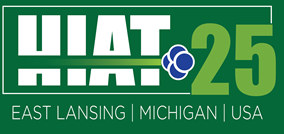|
Topic |
Title |
Presenter (affiliation) |
|
MC1: Circular Accelerators and Storage Rings |
||
|
Single-bunch extraction at the 88-Inch Cyclotron |
Michel Kireeff Covo (Lawrence Berkeley National Laboratory) |
|
|
In relation to beam halo issues for high power/high luminosity accelerators |
Milica Rakic (Ecole Polytechnique Fédérale de Lausanne) |
|
|
MC2: Room Temperature and Superconducting Linacs |
||
|
Primary beam development for FRIB experiments |
Tomofumi Maruta (Facility for Rare Isotope Beams, Michigan State University) |
|
|
Operation status of China Accelerator Facility for Superheavy Elements (CAFe2) |
Weilong Chen (Institute of Modern Physics, Chinese Academy of Sciences) |
|
|
RF power limits of 4-rod RFQs |
Holger Podlech (Goethe Universität Frankfurt) |
|
|
Nb3Sn superconducting cavity developments for heavy-ion beams |
Troy Petersen (Argonne National Laboratory) |
|
|
Megawatt uranium beam operation at GSI UNILAC |
Winfried Barth (GSI Helmholtzzentrum für Schwerionenforschung GmbH) |
|
|
MC3: Stable and Radioactive Ion Beam Facilities |
||
|
FRIB operational experience |
Jie Wei (Facility for Rare Isotope Beams, Michigan State University) |
|
|
RIBs production at IJCLab |
Enrique Minaya Ramirez (Université Paris-Saclay, CNRS/IN2P3, IJCLab) |
|
|
Progress and status of high intensity heavy ion accelerator facility (HIAF) in China |
Jiancheng Yang (Institute of Modern Physics, Chinese Academy of Sciences) |
|
|
nuCARIBU commissioning and initial operation |
Clayton Dickerson (Argonne National Laboratory) |
|
|
GANIL, The French National Ion Accelerator: operation of today and the upcoming projects for the next 20 years |
Hanna Franberg Delahaye (Grand Accélérateur Nat. d'Ions Lourds) |
|
|
Operation status of the RAON facility |
Yeonsei Chung (Institute for Basic Science) |
|
|
MC4: Accelerator Systems and Components |
||
|
Demonstration of cavity field mapping by falling drops of liquid |
Xiaonan Du (GSI Helmholtzzentrum für Schwerionenforschung GmbH) |
|
|
NEWGAIN project at GANIL: construction of the new heavy ion injector for the superconducting LINAC |
Frederic Chautard (GANIL) |
|
|
MC6: Operations, Controls, Computations |
||
|
Maintaining optimal beam brightness and luminosity using machine learning |
Weijian Lin (Brookhaven National Laboratory) |
|
|
Automated beam tuning of the TRIUMF ISAC facility |
Paul Jung (TRIUMF) |
|
|
Recent developments of machine-learning-based techniques in RIKEN RI Beam Factory |
Takahiro Nishi (Nishina Center for for Accelerator-Based Science) |
|
|
Future challenges for CERN’s ion injector complex |
Maciej Slupecki (European Organization for Nuclear Research) |
|
|
Boost of ALPI superconducting linac performances using AI techniques |
Luca Bellan (Istituto Nazionale di Fisica Nucleare) |
|
|
MC7: Ion Sources, Traps, and Charge Breeding |
||
|
Measurement of forward-directed neutrons generated by an inverse kinematic reaction using incident 7Li3+ beam |
Toshiro Sakabe (Brookhaven National Laboratory) |
|
|
High current heavy ion acceleration: 55 mA of Al11+ achieved, 100 mA expected |
Masahiro Okamura (Brookhaven National Laboratory) |
|
|
Demonstration of closed shell breeding of cesium with an EBIS |
Richard Vondrasek (Argonne National Laboratory) |
|
|
Design of past, present and future superconducting magnets for ECR ion source |
Yang Ye (Lawrence Berkeley National Laboratory) |
|
|
High intensity Ti-50 beam production for superheavy element research |
Damon Todd (Lawrence Berkeley National Laboratory) |
|
|
Status of High Performance ECR ion sources: achievements and perspectives |
Liangting Sun (Institute of Modern Physics, Chinese Academy of Sciences) |
|
|
Production and Charge Breeding for Post-acceleration of the First RI Beam from RAON ISOL facility |
Kyounghun Yoo (Institute for Basic Science) |
|
|
MC9: Ion-material Interaction, Strippers, Targets, Beam Dumps |
||
|
Operation of a pulsed gas stripper during regular user beam time at GSI |
Peter Gerhard (GSI Helmholtzzentrum für Schwerionenforschung GmbH) |
|
|
Strippers and high power targetry |
Takuji Kanemura (Facility for Rare Isotope Beams, Michigan State University) |
|
|
MC10: Applications: Medical, Materials, Isotopes, Space, and others |
||
|
Mimicking the radiation environment of interplanetary space in the laboratory; the BNL proposed high energy effects test facility |
Trevor Olsen (Brookhaven National Laboratory) |
|
|
High energy ion implantation at BNL |
Dannie Steski (Brookhaven National Laboratory) |
|
|
Recent developments in low and medium energy ion beam facilities for radiation effects testing |
Steven Lidia (Facility for Rare Isotope Beams, Michigan State University) |
|
|
MC11: New Concepts and Applications for Heavy Ion Acceleration |
||
|
Recirculating and energy recovery ion linear accelerators |
Ji Qiang (Lawrence Berkeley National Laboratory) |
|
|
A charge stripper ring for RIBF |
Hiroshi Imao (RIKEN Nishina Center) |
|
|
In relation to a sustainable approach considering the design and operation of accelerators |
Maud Baylac (CNRS – LPSC) |
|
|
The introduction of the compact laser-driven proton therapy system at Peking University |
Kedong Wang (Peking University) |
|

